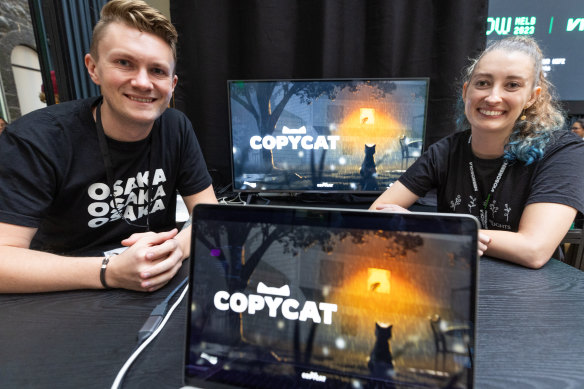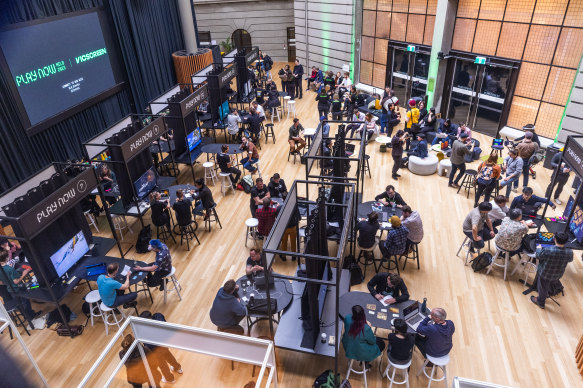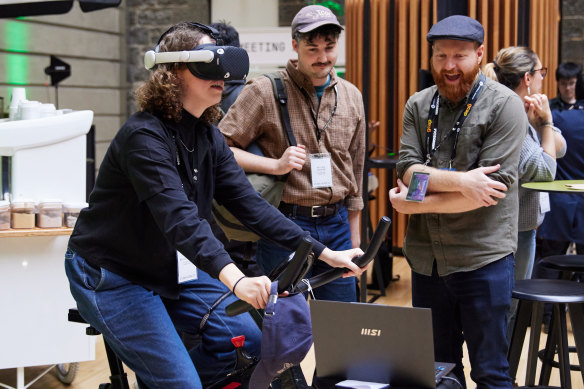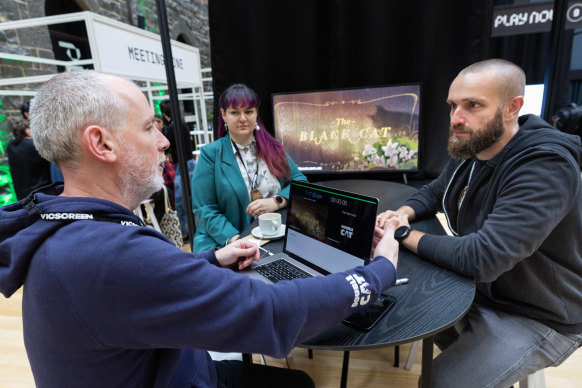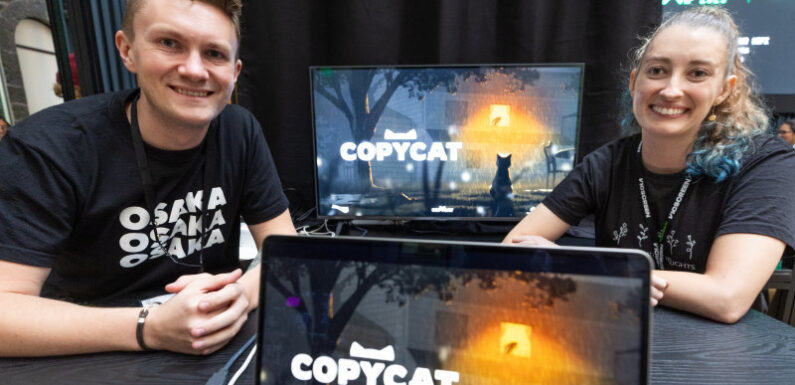
By Karl Quinn
Kostia Liakhov and Samantha Cable developed their game Copycat at nights and weekends over the past two years. Now they hope to unleash it on the world.Credit: Jason South
Save articles for later
Add articles to your saved list and come back to them any time.
It doesn’t look like much, but in a side room at the State Library of Victoria the biggest thing to hit the gaming scene in Australia in years, possibly ever, is underway.
The inaugural Play Now event has brought together a dozen international publishers and three times as many local developers from all over Australia for a speed dating-style forum. In 20-minute blocks, developers pitch their ideas, demonstrate their work-in-progress, and hope and pray there’s enough there to entice one of these big players to stump up the cash to take their concept to the next level, and to the enormously lucrative global gaming market.
“Our ideas are very unique and diverse, and the world is hungry to hear them,” says Caroline Pitcher, chief executive of VicScreen, the state agency that has staged the one-day meet-and-greet. “We want to export Australian IP to the world, to tell our unique stories through games.”
If any of the developers here today succeed, the rewards are potentially massive. Globally, the digital game market was worth $240 billion in 2020. By next year it is predicted to be worth $294 billion.
A dozen international computer game publishers and more than 30 Australian developers met in Melbourne this week for Play Now, a one-day speed-dating event out of which the next big thing might just emerge.Credit: Jason South
By comparison, the global market for film and home entertainment, excluding pay TV, was worth just under $140 billion in 2021, while the recorded music industry was last year valued at $42 billion.
Video games are, in other words, the single biggest component of the entertainment industry worldwide.
Australia’s slice of the pie is small at the moment – just $226 million, and 1300 full-time employees in 2020-21. But with most of the revenue coming from overseas markets, there’s plenty of faith it can grow significantly, with the right kind of help.
In a submission to government in 2021, the Interactive Games and Entertainment Association said “if a tax offset and direct funding were introduced, we believe Australia’s game development sector would grow … to employ 10,000 full-time workers and generate $1 billion a year by 2030”.
It took a while, but eventually that argument was heeded. Last year, the federal government introduced the Digital Games Tax Offset, a 30 per cent rebate through the tax system (similar to the producer offset available to the film and television sector).
In January 2023, the government committed $12 million over four years to support games through Screen Australia, restoring funding that was cut under the Abbott government in 2014. Developers can also tap into state subsidies of 10 per cent in Victoria, South Australia and New South Wales, and 15 per cent in Queensland. In all, state and federal subsidies can contribute between 40 and 45 per cent of the cost of a game’s development in Australia.
Victoria is the nation’s centre of games activity, with almost half the 400 businesses based in the state, in large part because VicScreen (previously known as Film Victoria) has supported the sector continuously for 30 years.
“We started off in multimedia, funding CD-ROMs, and now we’re funding unbelievable games like Cult of the Lamb and Untitled Goose Game,” says Pitcher. “We’ve come a long way.”
So has Daniel Lucic. The marketing manager for indie publisher Devolver has travelled from Croatia to be at this event. His company, which has offices in Austin, London, Tokyo, San Francisco and many more outposts besides, has history with Australia, having published a local game that has become a global smash.
“Cult of the Lamb is a huge hit for us, and a huge hit for Australia,” he says, sitting on a marble staircase in a break between 20-minute meetings with hopefuls. “It was a multimillion seller, and it’s still going strong.”
Devolver receives more than a hundred pitches each month, he says, mostly via email with sample gameplay attached – anything from 10 or 20 minutes to a couple of hours, depending on the complexity of the narrative and the experience. “We say no to 90 per cent – way more than 90 per cent,” he says. Typically, they might say yes to just nine or 10 a year.
He’s come to this event hoping to find the next left-field hit, and by lunchtime he’s already thinking he might have. “It really spoke to me, to my experiences,” he says of the game, whose title he would rather keep quiet at this stage.
Unlike some of its Triple-A major publishing house rivals (like EA and RockStar), Devolver doesn’t buy out the rights to a game it likes. Rather, it partners with the developer to help bring it to market. That might mean funding further development, marketing, and the production and distribution of physical copies, should that be part of the plan.
According to Lise Leitner, coordinator of games and interactive at VicScreen, a publisher might take 30 per cent of a game’s sales price as its commission, and the platform on which it is distributed could take another 20. But that still leaves the developer with 50 per cent, and on a $30 game, say, that’s not to be sneezed at.
“In some other countries, if you make money there’s an expectation that you pay it back [to the funding agency],” she says. In Australia, it is mostly given as a grant. “And what we see is that creates sustainability and stability in the sector,” she says. “Because if people make a profit, they can keep that and use that for their next project.”
The big end of the gaming market might be dominated by car racing, sports and first-person shooters, but a wander through the stalls at Play Now offers a glimpse of the diversity the indie sector has to offer. There’s a fashion-based game in which the aim is to look spectacular; a domestic spin on Dungeons and Dragons called Dungeons and Dining Tables; a VR game in which the player uses a real-world exercise bike to power a game-world motorbike through heavy traffic.
“It’s not a fitness game,” insists Adelaide-based developer Jonathan Kovarch of his Pedal Rebel VR. “It’s a game where there’s a fitness component, and it just makes the game feel way better.”
Kovarch (right) demonstrates his Pedal Rebel VR game at Play Now.
He has developed his game as a hobby, and estimates his start-up costs to be about $70 so far – $50 for the second-hand exercise bike he bought on Facebook Marketplace, the rest for a string of LED lights from Bunnings.
Alan Downie and Sher Rill Ng of Double Cat, on the other hand, have invested about $300,000 since May on their offering, a beautifully rendered, empathy-based game based on Edgar Allan Poe’s short story The Black Cat.
If the outlay is substantial, so is the ambition.
“This story was written 180 years ago about alcoholism and domestic violence, which are still very strong issues today, obviously,” says Downie. “You don’t really see many interactive experiences dealing with strong issues like that, and that’s something we wanted to do.
“We want the player to be reflective of their own relationships, by playing as this character and being able at some point to recognise the character they’re playing as is not a nice person.”
In other words, the game seeks to subvert the usual role-playing experience in order to get the player to reflect upon real-world situations.
“I really hope that people will reflect on their own relationships, and the relationships of the people around them, and be able to recognise some of those behaviours and be able to go, ’hey, you know what, that’s not cool,” Downie says.
Cats feature prominently in the work of Samantha Cable and Kostia Liakhov too. The Sydney-based couple, who met at an ad agency in Germany a decade ago, have brought their game Copycat, in which a moggy is kicked out of the house and replaced by a lookalike interloper.
Devolver’s Daniel Lucic, right, travelled from Croatia to see what Australia’s games developers had to offer. Alan Downie, left, hoped he might entice him with his Edgar Allan Poe-inspired game The Black Cat.Credit: Jason South
“Copycat is a narrative driven indie game about the meaning of home, set in the Australian suburbs,” says Cable, with all the precision of a copywriter who has honed her pitch to perfection. “It follows themes of love, loneliness, and letting go as it progresses through three hours of gameplay. And it’s about cherishing the human-pet bond in all its forms.”
They’ve developed the game on their own time, at nights and weekends, for about two years. With Screen Australia funding, they were able to quit their day jobs earlier this year and devote themselves fully to the project. They reckon it’s about 75 per cent ready to go, “which is probably a bit further than some publishers might like” Ukrainian-born Liakhov admits.
Whether its advanced state of development proves a plus or a minus with the publishers remains to be seen, but the game has already started to develop a following on the platforms where a test version has been made available.
They’ve attracted about 35,000 followers on social media, and Copycat was recently nominated for game of the year, much to Liakhov’s surprise.
“It felt kind of bizarre,” he says. “We had a little bit of imposter syndrome because game’s not even finished yet. It was like if a trailer won an Oscar, you know.”
Not that they’re complaining. It gives them hope that they’re on the right track with their pet project.
And if it is a hit, how big do they think it could be?
“It’s hard to put any numbers on it,” Cable says. “We just hope it allows us to keep doing what we love and fund our next project.”
Five great homegrown games you (possibly) didn’t even know were Australian
Real Racing (2009, Firemint, Melbourne) Built for Apple devices, this racing game features 48 cars and 12 fictional tracks, at least one of which looks suspiciously like the town in which the game was built.
Fruit Ninja (2010, Halfbrick, Brisbane) Fruit is tossed in the air. Your job is to slice it, by swiping your finger across the screen. But watch out for the bombs – slice those, and you’re salad.
LA Noire (2011, Bondi Studios, Sydney) Is what it says on the box: set in Los Angeles in 1947, this is a hard-boiled role-playing detective game. The HBO series Perry Mason surely took some inspiration from this one.
Untitled Goose Game (2019, House House, Melbourne) You play the role of an annoying goose who wanders about a quaint English village harassing the humans, stealing food, and generally going about its business as if it owned the place.
Cult of the Lamb (2022, Massive Monster, Melbourne) Cute-meets-creepy in a game about a sacrificial lamb who comes back from the dead to set up a cult and defeat an array of evil bishops.
Contact the author at [email protected], follow him on Facebook at karlquinnjournalist and on Twitter @karlkwin, and read more of his work here.
Most Viewed in Culture
Source: Read Full Article
